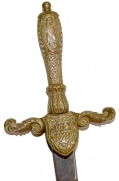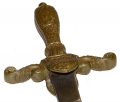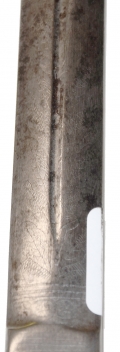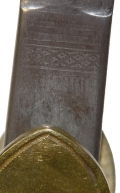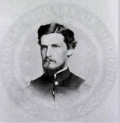site search
online catalog
SCARCE INSCRIBED MODEL 1840 MEDICAL STAFF SWORD BY N.O. BENJAMIN, NEW YORK: ASSISTANT SURGEON HENRY SAYLER SCHELL, US ARMY 1861-1869, BULL RUN CAMPAIGN, GAINES MILL, FREDERICKSBURG, POST SURGEON FORT LARAMIE 1867-1869

$2,750.00 SOLD
Quantity Available: None
Item Code: 2020-470
We know of only one other medical staff sword made by Benjamin, formerly in the Kevin Hoffman collection. Benjamin went into the military goods and sword business in early 1861 with Virgil Price, who expanded from masonic regalia to military goods at 424 Broadway in New York City. By October 1861, Benjamin seems taken over the address, which he advertised as his factory, but his last business listing is in 1862 and Alfred Woodham, former owner of a “sportsman’s depot” was at the address selling guns and fishing tackle not long after. Whether Benjamin remained there or was partners with Woodham is unknown. Benjamin had advertised for metal workers, indicating he was making at least some of his own sword parts. Kevin Hoffman felt he might have been purchased the hilt and fittings for the medical staff in his collection and been mostly involved in fitting his own blades.
The sword follows the regulation pattern for the US Model 1840 Medical Staff sword, derived from Virginia presentation swords of the 1830s and worn by US Army surgeons and assistant surgeons throughout the Civil War. The gilt brass small sword style hilt is cast with oak leaves, acorns, and acanthus leaves, scrolled quillons with leaf designs, and shield-shaped langets, the reverse blank and the obverse cast with “MS” and stars surrounded by a wreath. The upper portion of the grip has a large oval at top, bearing on the obverse an eagle with arrows and olive branch. The eagle resembles somewhat those appearing on Schuyler, Hartley and Graham marketed hilts and the head and crest has a Germanic aspect similar to Philadelphia “Prahl” eagle head pommels. One difference from the regulation pattern and the Hoffman example is the pommel finial used on this, which is much rounder and less detailed than the standard pineapple form.
The blade on this is oval with a central fuller and is drypoint etched at the ricasso “O.N. Benjamin / NY” in script. This form of blade is noted on some other medical staff swords, but differs from the Hoffman example. The blade address is also shorter, omitting a street address, and also transposes Benjamin’s initials, perhaps indicating Benjamin was scrambling to make good in the business. The blade is a muted silver with dark gray spots. The etched motifs are visible and largely floral, oak leaves, with a panoply of flags and a shield on one side and on the other, “Medical Department” rather than “medical staff.” The latter might have been expected from the “MS” langet. The terms were sometimes used inconsistently, though it might imply he was not assigned to a particular regiment. The scabbard body is blued steel, oxidizing toward brown with a typical purple cast, missing the throat, but retaining a nice surface color and free of rust or dents. The ring mounts and drag are present, plain on the reverse and on the obverse cast with standard geometric and floral designs seen on other medical staff swords.
The oval panel on the reverse of the grip is nicely engraved in period script, “Henry S. Schell.” Schell was born in Pennsylvania 6/1/1835 and died in San Diego in 1890. He received his medical diploma from the University of Pennsylvania in 1857, and after serving a term as Resident Physician of the Episcopal Hospital, practiced medicine in Philadelphia. Heitman and other records indicate Schell was commissioned Assistant Surgeon, US Army, on 8/5/61, but this is likely the formal date of his commission, which often ran late, and he seems to have joined the army’s medical staff at the beginning of the war. The Medical and Surgical History of the war has excerpts from Schell’s “Narrative of His Experiences in the Medical Staff” indicating he was ordered to organize a hospital at Alexandria on July 16, 1861, and on the evening of the Battle of Bull Run was ordered to report to McDowell, who sent him with Surgeon W.S. King and a train of 39 ambulances to recover two officer’s bodies from the Bull Run battlefield, aid the wounded on the field and, if possible, evacuate them. (The mission was unsuccessful.)
Excerpts of his “Narrative” also indicate he was assigned as the medical officer for two regular army batteries of the 2nd and 3rd Artillery, and a squadron of regular cavalry in August 1861, and that he accompanied those batteries on the Peninsular Campaign, seeing action and treating wounded as early as Yorktown. He saw further action at Hanover Court House and at Gaines Mill, where he remained with one other assistant surgeon at a field hospital to tend his patients as the rest of the army withdrew in McClellan’s “Change of Base.” Benjamin reported on the horrendous condition of the hospital in the middle of the battlefield and its high mortality rate, with medical supplies having been withdrawn and little food or water. A eulogy later printed in the MOLLUS records says that he actually went into Richmond and obtained medical supplies from physicians there (giving the story a rosier hue,) but he makes no mention of that in his narrative. He does mention scanty rations provided by Confederate authorities, however, and the useless half-dozen paroled U.S. prisoners he was given as assistants. A second excerpt from his narrative details his experiences with the same batteries at Fredericksburg, where he crossed the river with them and they were under fire of, “artillery and musketry about three hours.”
Further record of Schell’s field service may yet surface, but we can place him at Cuyler U.S. Army Hospital in Germantown, PA, in 1864-1865, and he was brevetted Captain and Major 13 March 1865 for faithful and meritorious service during the war. In 1866 he was Post Surgeon at Savannah, which was suffering from a severe outbreak of cholera, and received a brevet to Lieutenant Colonel 28 September 1866 for “meritorious and distinguished service at Tybee Island and Savannah Georgia where cholera prevailed.” From October 1867 we find him as Post Surgeon at Fort Laramie, a very active location in the early Indian Wars. He apparently reported not only on the “sanitary conditions” of the post, but wrote a history of its medical department, which exists in a typescript in the NPS museum there. One event is recorded in other sources: while there he treated Col. Henry Carrington of the 18th US Infantry for an accidental gunshot wound in early 1867. Schell took leave of absence in late 1868 and resigned from the army July 10, 1869, returning to Philadelphia to practice medicine, principally ophthalmic surgery.
Schell was a member of MOLLUS and a memorial notice eulogized him as one, “never known to swerve from the very highest standard of honor in all his professional and social relations. He had an extensive acquaintance with literature and a nice taste in art, was a most agreeable companion, and was a general favorite in a wide circle of friends where his loss is deeply felt.” He died in California, unmarried, and left his estate to his two sisters.
This is a regulation Civil War medical staff officer’s sword by a very scarce maker and one carried by officer whose record may yet have more to offer. [sr]
[sr]
~~~~~~~~~~~~~~~~~~~~~~~~~
THIS ITEM, AS WITH ALL OTHER ITEMS AVAILABLE ON OUR WEB SITE,
MAY BE PURCHASED THROUGH OUR LAYAWAY PROGRAM.
FOR OUR POLICIES AND TERMS,
CLICK ON ‘CONTACT US’ AT THE TOP OF ANY PAGE ON THE SITE,
THEN ON ‘LAYAWAY POLICY’.
THANK YOU!
Inquire About SCARCE INSCRIBED MODEL 1840 MEDICAL STAFF SWORD BY N.O. BENJAMIN, NEW YORK: ASSISTANT SURGEON HENRY SAYLER SCHELL, US ARMY 1861-1869, BULL RUN CAMPAIGN, GAINES MILL, FREDERICKSBURG, POST SURGEON FORT LARAMIE 1867-1869
For inquiries, please email us at [email protected]
Most Popular
Historical Firearms Stolen From The National Civil War Museum In Harrisburg, Pa »
Theft From Gravesite Of Gen. John Reynolds »
Cavalry Carbine Sling Swivel »
Fine Condition Brass Infantry Bugle Insignia »
featured item
CONFEDERATE FIRST NATIONAL FLAG FROM ISLAND NUMBER TEN
This Confederate First National flag has a tight provenance going back to 1935, and before that an oral history as a war souvenir brought back from Island Number Ten by James William McLaughlin, a prominent Cincinnati architect who in 1861 had served… (1179-004). Learn More »






